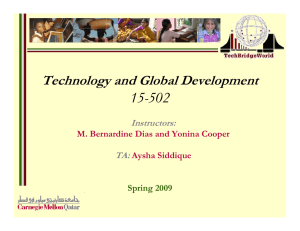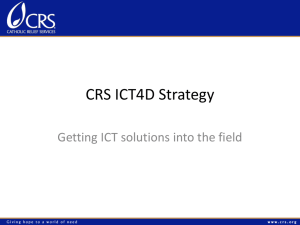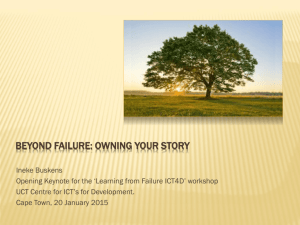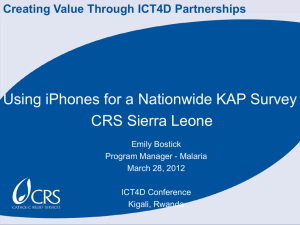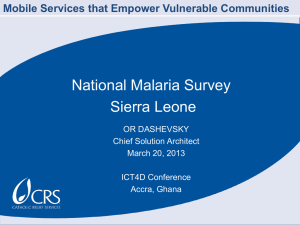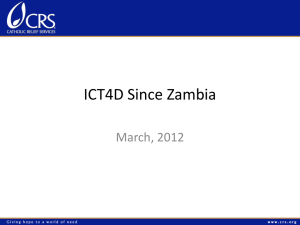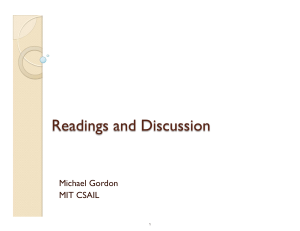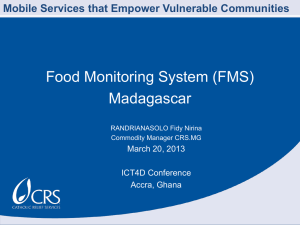ICTD interventions: trends over the last decade
advertisement
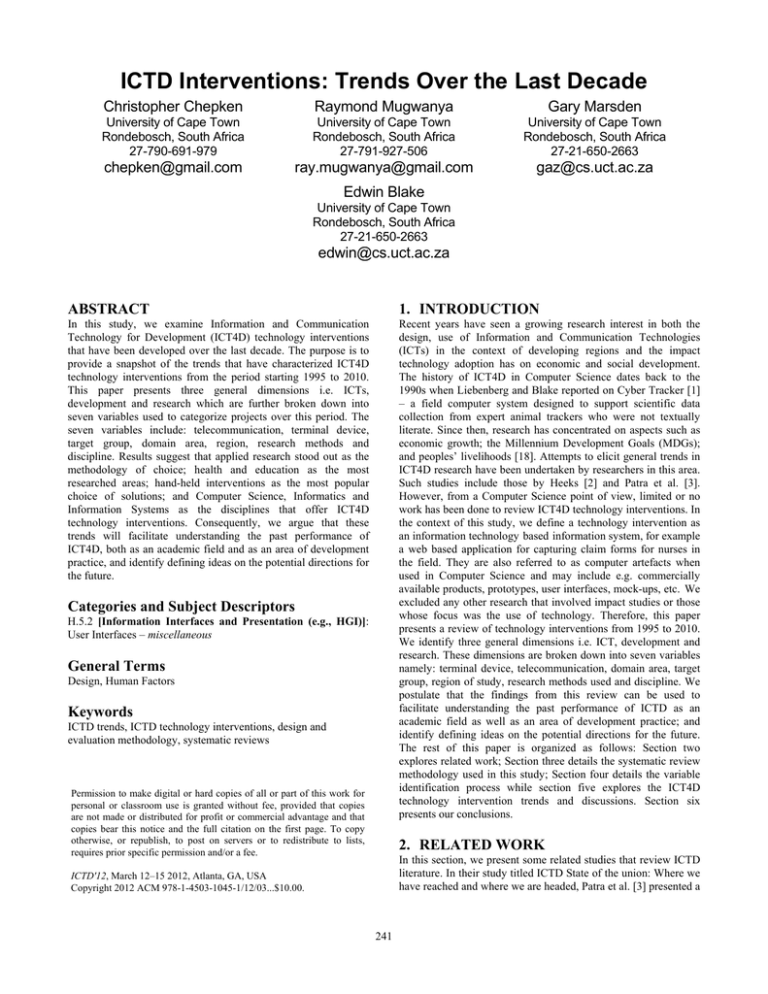
ICTD Interventions: Trends Over the Last Decade
Christopher Chepken
University of Cape Town
Rondebosch, South Africa
27-790-691-979
chepken@gmail.com
Raymond Mugwanya
University of Cape Town
Rondebosch, South Africa
27-791-927-506
ray.mugwanya@gmail.com
Gary Marsden
University of Cape Town
Rondebosch, South Africa
27-21-650-2663
gaz@cs.uct.ac.za
Edwin Blake
University of Cape Town
Rondebosch, South Africa
27-21-650-2663
edwin@cs.uct.ac.za
ABSTRACT
1. INTRODUCTION
In this study, we examine Information and Communication
Technology for Development (ICT4D) technology interventions
that have been developed over the last decade. The purpose is to
provide a snapshot of the trends that have characterized ICT4D
technology interventions from the period starting 1995 to 2010.
This paper presents three general dimensions i.e. ICTs,
development and research which are further broken down into
seven variables used to categorize projects over this period. The
seven variables include: telecommunication, terminal device,
target group, domain area, region, research methods and
discipline. Results suggest that applied research stood out as the
methodology of choice; health and education as the most
researched areas; hand-held interventions as the most popular
choice of solutions; and Computer Science, Informatics and
Information Systems as the disciplines that offer ICT4D
technology interventions. Consequently, we argue that these
trends will facilitate understanding the past performance of
ICT4D, both as an academic field and as an area of development
practice, and identify defining ideas on the potential directions for
the future.
Recent years have seen a growing research interest in both the
design, use of Information and Communication Technologies
(ICTs) in the context of developing regions and the impact
technology adoption has on economic and social development.
The history of ICT4D in Computer Science dates back to the
1990s when Liebenberg and Blake reported on Cyber Tracker [1]
– a field computer system designed to support scientific data
collection from expert animal trackers who were not textually
literate. Since then, research has concentrated on aspects such as
economic growth; the Millennium Development Goals (MDGs);
and peoples’ livelihoods [18]. Attempts to elicit general trends in
ICT4D research have been undertaken by researchers in this area.
Such studies include those by Heeks [2] and Patra et al. [3].
However, from a Computer Science point of view, limited or no
work has been done to review ICT4D technology interventions. In
the context of this study, we define a technology intervention as
an information technology based information system, for example
a web based application for capturing claim forms for nurses in
the field. They are also referred to as computer artefacts when
used in Computer Science and may include e.g. commercially
available products, prototypes, user interfaces, mock-ups, etc. We
excluded any other research that involved impact studies or those
whose focus was the use of technology. Therefore, this paper
presents a review of technology interventions from 1995 to 2010.
We identify three general dimensions i.e. ICT, development and
research. These dimensions are broken down into seven variables
namely: terminal device, telecommunication, domain area, target
group, region of study, research methods used and discipline. We
postulate that the findings from this review can be used to
facilitate understanding the past performance of ICTD as an
academic field as well as an area of development practice; and
identify defining ideas on the potential directions for the future.
The rest of this paper is organized as follows: Section two
explores related work; Section three details the systematic review
methodology used in this study; Section four details the variable
identification process while section five explores the ICT4D
technology intervention trends and discussions. Section six
presents our conclusions.
Categories and Subject Descriptors
H.5.2 [Information Interfaces and Presentation (e.g., HGI)]:
User Interfaces – miscellaneous
General Terms
Design, Human Factors
Keywords
ICTD trends, ICTD technology interventions, design and
evaluation methodology, systematic reviews
Permission to make digital or hard copies of all or part of this work for
personal or classroom use is granted without fee, provided that copies
are not made or distributed for profit or commercial advantage and that
copies bear this notice and the full citation on the first page. To copy
otherwise, or republish, to post on servers or to redistribute to lists,
requires prior specific permission and/or a fee.
2. RELATED WORK
In this section, we present some related studies that review ICTD
literature. In their study titled ICTD State of the union: Where we
have reached and where we are headed, Patra et al. [3] presented a
ICTD'12, March 12–15 2012, Atlanta, GA, USA
Copyright 2012 ACM 978-1-4503-1045-1/12/03...$10.00.
241
as Google Scholar, ACM, IEEE and Science Direct among others.
These searches covered the time period between 1995 and 2010
because we believe that it is around 1995 that ICTD research
started. Moreover, it is in this time period that Liebenberg and
Blake reported on Cyber Tracker [1]. The keyword searches
proved challenging because ICTD as a discipline is relatively
young, and the first ICTD conference was only held five years
ago in 2006 [6]. We therefore adapted the snowball sampling
technique for our review by identifying key researchers in the
ICTD field via scanning through recent ICTD proceedings (i.e.
Kentaro, Heeks, Donner, etc.); searched through their personal
Websites for published works and through bibliographies of their
articles to obtain further studies. What started out as a reasonably
large body of studies (i.e. over 400) conference and journal papers
was trimmed significantly. A total of about 220 articles were
excluded based on their titles and abstracts. This was followed by
a further inclusion/exclusion of articles based on whether they
presented ICT4D technology interventions in literature as their
core. ICTD is a multidisciplinary field where researchers are not
necessarily required to create technology in order to publish their
findings in conferences and/or journals. These researchers are to a
great extent typically interested in the impact of technology and
using ethnographies to explore its use. However, as computer
scientists interested in designing technology, what trends should
we look out for? Or what should other researchers look out for? In
order to achieve this goal, a total of 116 articles met the selection
criteria and were presented for further review. 23 articles were
then excluded because despite having relevant titles, abstracts and
full text, they did not offer/present technological interventions
which left us with 93 articles for further analysis (see
http://people.cs.uct.ac.za/~cchepken/ICTD2012Bib.pdf). In the
following section, we describe the variables derived from our
review.
literature review and interviewed 50 ICTD researchers in order to
examine the history and growth of ICTD since the 1990s. Their
study revealed the trends defining ICTD research and examined
the progress in areas that have come to dominate discussion in
ICTD; for example the researchers areas of affiliation and
practice, area of specialization, location of researchers and areas
of future importance among others.
In another review, Bussell [4] highlights key trends on the uses of
technology and the goals of ICT for development initiatives. She
further reveals perspectives, potential barriers to success and
strategies for overcoming these barriers. She analyzed 39 reports
produced in the period 1994-2005 by ten different organizations.
In another study by Hedström and Grönlund [5], they reviewed
literature from ICTD journals. They investigated the degree to
which case study research on eGovernment and ICTD focuses on
ICTs role for development in developing countries or regions and
examined the extent to which evaluations of ICTD-projects focus
on development assessment. Ho et al. in their work [6] reviewed
the past, present and future of Human Computer Interaction for
Development (HCI4D) research in order to articulate some of the
histories and provide an overview of existing work in HCI4D
spanning numerous venues and research traditions. In particular,
the review aims to emphasize works that are representative of
major trends and topics identified in the various workshops at
CHI, Mobile HCI, Interact, Participatory Design Conference
(PDC), and DIS, as well as ongoing discussions within the IFIP
Special Interest Group. They relate them to one another to provide
a conceptual roadmap for making sense of this emerging
literature.
Research work involving technology interventions has evolved
differently over time in different regions due to different
constraints. For instance the developed world, has witnessed a
trend towards cloud based services, green computing and so on
whereas in developing countries which are typically characterized
by a high prevalence of cell phones, technology interventions
should evolve differently. However, to the best of our knowledge,
there is limited research that reviews ICT4D technology
interventions. It is therefore on this basis that this paper attempts
to highlight trends that have characterized ICT4D technology
interventions over the last decade.
4. VARIABLE IDENTIFICATION
In order to identify and describe the variables derived from our
critical analysis of ICT4D technology interventions literature, we
utilize the work presented by Heeks [2], Kjeldskov and Graham
[8] and Gitau et al. [10] to provide the framework for this section.
We identify three broad dimensions derived from the
conceptualization of ICT4D – which deals with the application of
ICTs within the fields of socio-economic development,
international development and human rights [23]. Therefore, the
first dimension is ICTs − which includes technologies that
facilitate via electronic means the creation, storage management
and dissemination of information [24]. The importance of ICTs is
to bridge digital divide by providing access to a target group. This
involves transmission of information and/or data from one point
to another. Once information or data has been transmitted, the
consumer needs a device to access and make use of it. Therefore
ICT is broken down into two variables namely:
telecommunication (as a result of data transmission through ICT
usage) and terminal device (through which the target groups
access data). In addition, the variables terminal device and
telecommunications were also adopted from Heeks who
distinguishes two phases of ICT4D while exploring various key
areas such as terminal devices, sustainability, scalability and
telecommunications among others.
3. METHODOLOGY
In this paper, we set out to identify emerging trends in ICTD
research particularly involving technology interventions. The
analysis in many aspects draws on a systematic review
methodology [7][22] and to some extent snowball sampling
[20][21]. A systematic review is a means of identifying,
evaluating and interpreting all available research relevant to a
particular research question, or topic area, or phenomenon of
interest whereas snowball sampling refers to a non-probability
sampling technique used in Statistics and Sociology where
existing study subjects recruit future subjects from among their
acquaintances. This sampling technique is often used in hidden
populations which are difficult for researchers to access. Example
populations would be drug users or sex workers and in the context
of this study, hidden population encompasses work presenting
ICTD technology interventions.
The second dimension is development which deals with
improving the social and economic livelihoods of the poor [25]
[26]. The development dimension can be broken down into three
variables i.e. target group or population; domain area (as ICT
The systematic review involved searching through conference and
journal articles using keywords i.e. “ICT4D interventions,
development, ICTD publications, etc” via online databases such
242
initiatives have different requirements for the various domains
e.g. agriculture, education, etc.); and region. Poverty is a key
word normally used in conceptualizing development and a
number of ICTD studies are undertaken in regions that are
characterized as developing or poorer e.g. Africa, Asia and Latin
America [2]. Gitau et al. [10] present an analysis of the role
played by African researchers in disseminating ICT4D research.
fixed line applications and visual display unit/television
(VDU/TV) based applications among others. The terminal devices
that could not be classified were categorized as others (see figures
2[a] and 2[b]).
Domain Area – In September 2000, building upon a decade of
major United Nations conferences and summits, world leaders
came together at United Nations Headquarters in New York to
adopt the United Nations Millennium Declaration, committing
their nations to a new global partnership to reduce global extreme
poverty (http://www.un.org/millenniumgoals/bkgd.shtml). In
order to achieve these, there was need for major reforms and
improvements in various economic sectors and most recently the
use of ICTs to foster human development. Borrowing from this,
we identify a number of domain areas derived from the MDGs
and other literature. The domain areas identified include:
Agriculture, Education, Health, Knowledge, Economics and
Fundamental Problems (see figure 3 for domain area analysis).
They go on to classify the regions from which ICT4D literature
tends to originate. Therefore, it is from research presented in [10]
that the variable region was derived. Target group and domain
area variables where derived from the conceptualization of
ICT4D studies and/or initiatives.
Table 1. Dimensions vs. variables.
Dimension
1
ICT
2
Development
3
Research
Variable
-
Telecommunication
Terminal device
Domain area
Target group
Region of study
Research methods applied
Discipline of study
Target Group – ICTD research is normally associated with target
users, groups or a problem area. In our review, we identify several
categories such as the rural poor, urban poor, problem as target
(which refers to articles such as those that attempt to solve a
caching problem or present applications for use in limited
bandwidth environments) and lastly developing world — those
projects that mention that they are developing technology for use
in these regions with no reference to any user group. Figure 4(a)
in the section that follows shows the distribution and frequencies
of target groups used in ICT4D projects over the last decade.
The last dimension is Research which is the core of this study. It
involves building technology interventions using methods from
various disciplines. Therefore, we break down the research
dimension into research methods and discipline of study [27].
Moreover, Kjeldskov and Graham review and classify mobile
HCI methods while relating them to their purpose(s). This review
uses the research methods presented in [8] and details their usage
trends over time. In addition, the millennium development goals
(MDGs) and people’s livelihoods indicators [19] provided the
domain area and discipline variables. The seven variables are as
illustrated in table 1 below and described thereafter.
Region – We classify articles based on geographical location in
which the research was undertaken. It is clear that majority of the
world’s poor originate from Asia, Africa and Latin America.
Figure 5 therefore gives a distribution indicating the regions
where ICT4D technology interventions have tended to
concentrate in the last decade.
Research Methods Used – Our review reveals that defining and
differentiating research methods is a challenging exercise. This is
because terminologies used are ambiguous, definitions sometimes
tend to be vague and often methods overlap and are not used in
their strictest sense. Since defining and differentiating research
methods is beyond the scope of this work, we adopt the
classification provided in [9] and reproduced in [8]. As a result,
we classify articles based on whether they applied any of the eight
methods, namely: Case Studies, Field Studies, Action Research,
Laboratory Experiments, Survey Research, Applied Research,
Basic Research and Normative Writings. Figures 6 and 7 give an
indication of the research methods and their distribution across
projects over the study period.
Telecommunication – Refers to the transmission of messages
over significant distances for the purpose of communication. In
earlier
times,
telecommunications
involved
the
use
of visual signals such as smoke, signal flags and audio messages
among others. VSATs during the 1980s and 1990s gave way to a
focus on land-based transmission systems. Most recently
according to Heeks [2], wireless is becoming the delivery mode of
choice to provide connectivity to poor communities in the
developing regions. We therefore categorize telecommunication
into the following variables: Internet, wireless telephone, wired
telephone, short range wireless, doesn’t need network and
Television. Figure 1 shows a graph with telecommunication
trends.
Discipline – In this section, we group our studies based on the
general subject area. Figure 8 indicates four areas, namely
Computer Science, Information Systems, Human Computer
Interaction and Multi–Disciplinary projects. ICT4D research as
presented in [2] and [10] spans many other disciplines such as
development studies, anthropology and ergonomics among others
but because we reviewed articles that presented technology
interventions, it was clear that they fell under the more technically
oriented subject areas such as Computer Science.
Terminal Device – Since the mid-nineties, models serving the
developed world consisted of a personal computer (PC) connected
via landline. Over time, researchers in ICTD and other disciplines
are realizing that globalization of technology is costly,
unsustainable and does not offer viable solutions due to the
various social, cultural and infrastructural constraints. Instead,
there is need for low-specification, low-cost, robust terminal
devices to meet the needs of the developing world poor. Within
the scope of this paper, “terminal devices” is used to refer to the
“technology intervention or end device that the user interacts
with”. As a result, we identify a number of terminal devices such
as: PC, Hand held devices e.g. personal digital assistants (PDAs),
5. RESULTS
In this section, we provide a descriptive analysis for each variable
to determine the distribution of ICT4D technology projects over
243
the terminal devices used in the last decade. The persistence of
the PC can be attributed to the fact that it was the de-facto
computing device most of the time covered by our survey. Fixed
line telephone terminals seem to have constituted a great share
over the last decade.
the last decade and highlight some factors that may have
contributed to the trends. We found that the early part of the
decade recorded very few ICT4D interventions possibly because
it is a fairly young discipline. Similarly, it is possible that
researchers and stakeholders initially focused more on large scale
projects like the Digital Villages. Below is an exploration of the
variables from which our trends are generated.
5.1 Telecommunications
In this sub-section, we present an analysis of telecommunications
and their usage distribution in ICT4D over the last decade.
Figure 2(a). Terminal/platform analysis.
Figure 1. Telecommunications.
Interventions that do not need a means of connectivity dominated
ICT4D technology projects prior to 2007. Although these
remained the choice of applications throughout the decade, they
were overtaken by internet and wireless telephone technologies in
2008 and 2009 respectively. A possible explanation for this is the
upsurge of mobile phones and internet penetration in developing
countries. It is during this time that a number of ICT4D studies
that utilized mobile phones started to rise. These studies might
have influenced the telecommunication trends during this period.
In 2007, 2009 and 2010, TV was seen as having the greatest
potential as the transmission mechanism compared to other
means. In fact, we envisage the re-emergence of TV as an
alternative means to counter the high cost of internet and mobile
telephone charges in developing countries.
Figure 2(b). Terminal percentages share.
5.3 Domain Area
In order to give an indication of the domain areas that have been
covered by ICT4D researchers over the last decade, we firstly
identify a number of areas from literature and partly through
various aspects for instance economic growth; the Millennium
Development Goals (MDGs) and people’s livelihoods [18]. As a
result, we identified a number of domain areas as presented in
figure 3. Clearly, health and education related technology
interventions dominated ICT4D research in the last ten years.
Agriculture started to appear in 2003, died out in 2004, rose in
2006 and started to decline thereafter. This may be because over
two thirds of the populations in developing countries depend on
agriculture as the main source of livelihood in addition to bad
climate conditions. In addition, research that focused on
economics/finance started appearing in 2005 and for reasons we
were not able to speculate, maintained its share in 2006 and 2009.
The domain categorization ‘other’ refers to interventions that
could not be classified into the general domain areas. These
include disaster, computer literacy, special groups, digital divide
and service provision.
5.2 Terminal Device
This variable describes the point of contact between the
technology intervention built and the end user. Figures 2(a) and
2(b) show the trends and distribution of terminal devices. In
particular, figure 2(a) reveals that since 2004 fixed line terminal
devices rose until 2006, remained fairly stable in 2007 and 2008
and dropped in 2010. The research that selected handsets as their
terminal device was mostly done in India, biased towards voice
applications and presented illiteracy as the problem they were
providing solutions for. Examples of such studies are presented in
[11], [12] and [13].
For the second half of the decade, hand held devices remained the
preferred terminal device of choice. They surpassed the personal
computer category after 2008 and since then, the number of
handheld based interventions has remained high. One reason that
can be advanced for this trend is the pervasiveness of mobile
phones and their ability to withstand the developing world’s
conditions that other terminal devices may not. Such conditions
may include intermittent electricity, poor infrastructure and high
cost. However, overall, the PC still remains the second most used
terminal device. It accounted for about 41.7% (see figure 2[b]) of
244
surprise, articles that use the urban poor as target groups
constituted 13.58% − the lowest in the group (see figure 4[b]). It
should be noted that urbanization in the developing world is on
the rise leading to an increasing number of urban poor in the cities
[15]. Therefore, one would have expected to see the urban poor as
a key target group.
5.5 Regions
Figure 3. Domain area.
5.4 Target Group
In this subsection, we present a distribution of the target users that
ICT4D research has tended to use over the last decade. Although
majority of the articles we reviewed make mention of their target
groups, others do not. In particular, researchers do not define
specific “problems as a target” when presenting their interventions’
but simply state that the solution is meant for the developing world.
Figure 4 shows the four different target groups identified.
An analysis of literature revealed the following as the regions for
the development of ICT4D technology interventions: Asia, Africa
and Latin America. Africa, despite having high poverty levels
[17] still ranks low compared to Asia and Latin America.
Moreover, research done in these regions tends to be done by
researchers from the developed world hence very limited
representation of scholars from the developing world [10]. Figure
5 reveals that up to 60% of all the ICT4D work was done in Asia,
most of it being done in India and by Indians, whereas 30% was
in Africa. ICT4D research involving technology interventions
done in Latin America only contributed 5%.
Figure 5. Percentage of ICT4D works by region.
5.6 Research Methods
Identifying and categorizing research methods is challenging
because some of the articles reviewed do not clearly describe
them [7]. In such cases, the authors made inferences from
descriptions of the approaches used, the target group(s) and the
general research processes. In instances where it was not clear
what methods were used, we classified them as “unspecified”.
Since this paper concentrated on analyzing technology
interventions, it was interesting to find that, as shown in figure 6,
applied research stood out as the most employed method across
the different areas, particularly in education, health and
agriculture. This was consistently followed by Field Studies over
the same time period. Action Research, Case Studies and Basic
Research did not appeal to researchers during this period. The
reason for this could be that their time requirements, commitment
and high cost due to the fact that majority of ICT4D work done to
date is undertaken by researchers from the developed world who
may not be in position to visit developing regions for long
durations.
Figure 4(a).Target groups.
Figure 4(b). Percentage of each target group.
Similarly, applied research seemed most popular with researchers
with a significant number of studies consistently undertaken in
Asia, followed by Africa and Latin America. This was followed
by field studies for the same regions and survey research (see
figure 8). ICT4D solutions are intended to enhance human
development in some way – hence the need for deployment in real
world contexts and the need for triangulation that applied research
methodologies provide. For instance during the different
phases/iterations in the various action research cycles, researchers
may be involved in using a number of methods such as
Figure 4(a) reveals that the focus of ICT4D research over the
review period was on the rural poor with 2009 presenting the
highest number of articles focusing on this group. The articles that
present “problem as a target” seemed to reduce from 2004 to
2005, remained constant up until 2008 and rose significantly in
2009. These results reiterate the arguments put forward in [14],
where they reveal that articles have tended to concentrate on users
living in rural areas, with low income and education levels and
present mobile phone applications based on these needs. To our
245
5.7 Research Discipline
ethnographies, participatory design, etc. which normally generate
richer data and reduce bias.
Heeks [2] predicted that champions of ICT4D should be drawn
from Computer Science, Human Computer Interaction and
Development Studies disciplines. However, our study reveals
contradictory results. For instance, the majority of the ICT4D
articles seemed to have been authored collaboratively with CS
and Health experts, Information Systems and agricultural experts
or HCI with finance researchers among others.
Figure 6. Methods vs. domain area.
Figure 8. Research disciplines.
Figure 8 shows the share of ICT4D articles within the various
disciplines over the last decade. Computer Science and
Informatics remains the highest contributor overall followed by
Information Systems. Clearly, in the last quarter of the decade,
multidisciplinary research grew considerably, getting to
comparable numbers with CS/informatics and IS research by
2010. This growth of multidisciplinary work goes against Raitis’s
comments that ICT4D is multidisciplinary while its authors are
predominantly not multidisciplinary [16]. Information Systems is
lagging behind HCI and CS, as traditionally IS researchers rarely
build technology in their research. Those categorized as “others”
include anthropology, engineering, economics, media and
development studies.
Figure 7. Methods vs. region.
ICT4D research covers a number of disciplines and as a result,
researchers have proposed the adoption of Social Science
methods. However, methods such as action research were applied
sparingly. One major reason for this may be because such
methods require that researchers spend several months in the
field. In an attempt to identify which methods were successful we
looked at project outcomes and attainment of research goals.
Evaluation outcome according to Heeks [28] can be measured by
whether or not different stakeholder groups attain their goals. We
therefore identify the following types of evaluation outcomes
namely: academic success – which refers to those projects that
were evaluated successfully in a laboratory environment;
deployment success – refers to those that were successfully
deployed in a real world setting; failure − those that failed; and
unclear – those in which the researchers could not ascertain their
success or failure.
6. CONCLUSIONS
This study was organized with the purpose of identifying
variables and the trends that have tended to categorize ICT4D
technology interventions over time. As a result, a systematic
review of ICT4D literature using a keyword index and article title
search was undertaken. Results suggest that Applied research
stood out as the methodology of choice; health and education as
the most researched areas; hand-held interventions as the most
popular choice of solutions; and Computer Science, Informatics
and Information Systems as the disciplines that offer ICT4D
technology interventions. Clearly, ICT4D has made strides since
the 1990s expanding the inclusion and use of research methods
used, the domain areas covered, terminal devices of choice, the
various target groups of interest by researchers, the research
disciplines and telecommunications choice. Overall, we found
that there was limited research activity in the latter half of the
1990’s and early half of the last decade. However, this increased
dramatically from 2006 after the hosting of the first international
ICTD conference. A fairly large body of ICTD researchers have
now been in the field long enough to think critically and
retrospectively on progress in this work. We hope that this
document will serve as another step in that direction.
From our review, deployment success seemed to dominate the
evaluation outcome. For instance projects such as those reported
in [32][33][34] presented deployment successes. This was
followed by academic successes presented in [29] [30][31]. We
also noted that some researchers mentioned that their projects
were not successful or did not meet their goals. In such instances,
such projects were considered to have failed (see for example
[35], [36] and [37]). In other cases, it was difficult to ascertain
success or failure of projects and thus projects evaluation outcome
was categorized as ‘unclear’. Examples of projects categorized as
unclear are [38] and [39].
246
7. ACKNOWLEDGMENTS
[13] Lahiri A., Chattopadhyay S. J. and Basu A. 2005. Sparsha: A
comprehensive Indian language toolset for the blind.
In Proceedings of the 7th international ACM SIGACCESS
conference on Computers and accessibility (Assets '05).
ACM, New York, NY, USA, 2005. 114-120.
Our sincere thanks go to the PERC Project and the Hasso Plattner
Institute for funding this research.
8. REFERENCES
[14] Wyche S., Smyth T., Chetty M., Aoki P. & Grinter R. 2010.
Deliberate interactions: characterizing technology use in
Nairobi, Kenya. Proceedings of the ACM Conference on
Human Factors in Computing Systems, 2010. 2593-2602
[1] Blake E.H., Steventon L., Edge J. and Foster A.: “A Field
Computer for Animal Trackers,” System: The 2nd South
African Conference on Human-Computer Interaction,
Pretoria (South Africa). [Online at:] www.chi-sa.org.za/CHISA2001/chisa2001New.htm {accessed} March 2011
[15] Wesolowski A. & Eagle N. 2009. Parameterizing the
Dynamics of Slums. AID 2009.
[2] Heeks R. 2008. ICT4D 2.0: The Next Phase of Applying ICT
for International Development. Computer 41, 2008. 26-33.
[16] Raiti G. 2006. The lost sheep of ICT4D research.
Information Technologies and International Development 3,
2006. 1-7.
[3] Patra R., Pal J., and Nedevschi S. 2009. ICTD state of the
union: Where have we reached and where are we headed.
2009 International Conference on Information and
Communication Technologies and Development (ICTD
2009). 357-366.
[17] Sachs J. et al. 2004. Ending Africa’s Poverty - Trap
Brookings Papers on Economic Activity [online at:]
http://www.unmillenniumproject.org/documents/BPEAEndin
gAfricasPovertyTrapFINAL.pdf {Accessed} March 2011.
[4] Bussell J. L (March 2011). International Norms on ICTs for
Development: New Data, Initial Findings and Opportunities
for Analysis. Paper presented at the annual meeting of the
American Political Science Association, Marriott Wardman
Park, Omni Shoreham, Washington Hilton, Washington, DC
[Online at:]
http://www.allacademic.com/meta/p41697_index.html
{Accessed} 2011-03-1
[18] Department for International Development (DfID) (2001):
Sustainable livelihoods guidance sheets, 1 to 7. [Online at:]
http://www.livelihoods.org {Accessed} March 2011.
[19] Millennium Development Goals [Online at:]
http://www.undp.org/mdg/basics.shtml {accessed} March
2011.
[5] Hedström K. and Grönlund A. 2008. The Quest for
Development – Reviewing ICT4D Research, GlobDev 2008.
[20] The Experiment.com resources Website. 2008-2011. [Online
at:] http://www.experiment-resources.com/snowballsampling.html#ixzz1O8HXUgzl {accessed} March 2011.
[6] Ho M., Smyth T., Kam M., & Dearden A. 2009: HumanComputer Interaction for Development: The Past, Present,
and Future. Information Technologies and International
Development 5, 2009, 1-18.
[21] Goodman, L.A. 1961. "Snowball sampling". Annals of
Mathematical Statistics 32 (1): 148–170.
doi:10.1214/aoms/1177705148
[22] Budgen .D and Brereton .P (2006) Performing systematic
literature reviews in software engineering. In Proceedings of
the 28th international conference on Software
engineering (ICSE '06). ACM, New York, NY, USA, 10511052. DOI=10.1145/1134285.1134500
http://doi.acm.org/10.1145/1134285.1134500
[7] Kitchenham B., Pearlbrereton O., Budgen D., Turner M.,
Bailey J. and Linkman S. 2009. Systematic literature reviews
in software engineering – A systematic literature review.
Information and Software Technology, vol. 51, 2009, 7-15.
[8] Kjeldskov J. and Graham C. 2003. A Review of Mobile HCI
Research Methods. In Proceedings of Mobile HCI 2003,
published by Springer-Verlag, 2003, 317-335.
[23] Medhi, I., Menon, G., and Toyoma, K. (2008): Challenges in
Computerized Job Search for the Developing World. In
Proceedings of the 26th international Conference on Human
Factors in Computing Systems, pp. 2079-2094. ACM
[9] Wynekoop J .L and Conger S. A. 1990. A Review of
Computer Aided Software Engineering Research Methods.
Proceedings of the IFIP TC8 WG 8.2 Working Conference
on the Information Systems Research Arena of the 90’s,
Copenhagen, Denmark, (1990).
[24] Alampay .N .E .T .A: Mapping Ict4d Projects in the
Philippines. [online at:]
http://www.ict4d.ph/proceedings/docs/ICT4D_Project_Inven
tory.pdf. {accessed} 14-10-2011
[10] Gitau S., Plantinga P. and Kathleen D. 2010. ICTD Research
by Africans: Origins, Interests, and Impact. Proceedings of
the 4th International Conference on Information and
Communication Technologies and Development ICTD,
(2010).
[25] Qureshi .S. (2009): Social and economic perspectives on the
role of information and communication technology for
development, Information Technology for Development,
15:1, 1-3
[11] Findlater L., Balakrishnan R. and Toyama K. 2009.
Comparing semiliterate and illiterate users’ ability to
transition from audio+text to text-only interaction.
Proceedings of the 27th international conference on Human
factors in computing systems - CHI ’09, (2009). 1751.
[26] Midgley .J (2003): Social development: the intellectual
heritage. Journal of International Development 15(7): 831—
844. Wiley Online Library
[27] Raiti, G.C. (2007): The Lost Sheep of ICT4D Research.
Information Technologies and International Development,
3(4). Pp. 1-7. USC Annenberg School for Communication &
Journalism
[12] Prasad A., Medhi A., Toyama K. and Balakrishnan R. 2008.
Exploring the feasibility of video mail for illiterate users.
AVI ’08: Proceedings of the working conference on
advanced visual interfaces, 2008. 103–110.
[28] HEEKS .R (2010): Failure, Success and Improvisation of
Information Systems Projects in Developing Countries.
247
International Conference on Social Implications of
Computers in Developing Countries, Dubai, UAE, May
2009. [Online at:]
http://www.ifip.dsg.ae/Docs/FinalPDF/Full%20Papers/ifip_2
5_nissila,%20tanhua,%20phuakinen.pdf {accessed} Nov
2010.
[Online at:]
http://unpan1.un.org/intradoc/groups/public/documents/nispa
cee/unpan015601.pdf. {accessed} Nov 2010
[29] Medhi .I, Gautama .S.N.N., and Toyama .K (2009): “A
comparison of mobile money-transfer UIs for non-literate
and semi-literate users,” Proceedings of the 27th
international conference on Human factors in computing
systems - CHI ’09, p. 1741.
[35] Frohlich .D.M., Jones .M, and Park .S (2009): “Democracy,
Design, and Development in Community Content Creation:
Lessons from the StoryBank Project,” Information
Technologies and International Development, vol. 5, pp. 1935.
[30] Medhi .I, Sagar .A, and Toyama .K (2007): “Text-Free User
Interfaces for Illiterate and Semiliterate Users,” Information
Technologies and International Development, vol. 4, pp. 3750.
[36] Chetty M (2006): Developing locally relevant applications
for rural South Africa: A telemedicine example. Unpublished
MSc, University of Cape Town, Cape Town, South Africa.
[31] Plauché .M (2006): “Tamil Market: A Spoken Dialog System
for Rural India,” In the proceedings of the IEEE CS and
ComSoc in Pervasive Computing English, p15-23.
[37] Cervantes .R and Sambasivan .N (2008): “VoiceList: Userdriven Telephone-based Audio Content,” MobileHCI 2008,
September 2–5, 2008, pp. 499-500. [37]
[32] Kumar .A, Rajput .A, Agarwal .S, Chakraborty . D and
Nanavati A. A. (2008): “Organizing the unorganized employing IT to empower the under-privileged,” Proceeding
of the 17th international conference on World Wide Web WWW ’08, p. 935.
[38] Sin .M, Escobedo .M, and Best .M (2004): “A directory
service for multi-literate users,” 2004 IEEE International
Conference on Multimedia and Expo (ICME) (IEEE Cat.
No.04TH8763), pp. 1295-1298.
[33] Blake E.H., Steventon .L, Edge .J and Foster .A (2001): “A
Field Computer for Animal Trackers,” System. Presented at
2nd South African Conference on Human-Computer
Interaction (CHI-SA2001). Pretoria, South Africa.
September [Online at:] www.chi-sa.org.za/CHISA2001/chisa2001New.htm {accessed} October 2011
[39] Sherwani .J, Ali .N, Mirza .S, Fatma .A, Memon .Y, Karim
.M, Tongia .R, and Rosenfeld .R (2007): “HealthLine:
Speech-based access to health information by low-literate
users,” International Conference on Information and
Communication Technologies and Development, Dec. 2007,
pp. 1-9.
[34] Nissilä .J (2010): “COOPWORKS – A CASE STUDY ON
AN INFORMATION SYSTEM MEANT TO ENHANCE
THE CAPACITIES OF AGRICULTURAL COOPERATIVES,” System. Proceedings of the 10th
248
